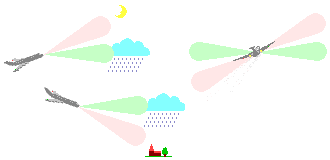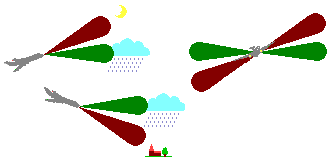Stabilisation (tilt and roll)


Figure 1: radar beam during tilt and roll
unstabilisated vs. stabilisated
Stabilisation (tilt and roll)
Clearly, aircraft in manoeuvres (such as during take off) would be 'pointing' their antenna beam at an area of airspace which they were not physically going to fly through. Maintaining accuracy during manoeuvres and other flight phases is important.
There are however considerable problems with maintaining this stability whilst 'in flight'. It is necessary to have some form of motorised equipment on-board in order to support this. Coping with mild manoeuvres such as shallow banked turns is less difficult than more pronounced roll and pitch changes.
Stabilisation can therefore only be expected to maintain a constant antenna sweep relative to the horizon during moderate manoeuvres. If stabilisation is not switched on, the display seen will mimic the direction and attitude of the aircraft.
For the vertical plane, it is normally quite clear that a manoeuvre could often be more pronounced than the eventual direction of the antenna in terms of the region of airspace to be intended. The vertical aspect of stability can be selected by the pilot if required. Airborne Weather Radar systems have a number of known problems during the take-off and landing phases of flight. Some systems may have a link to the Autopilot (otherwise, a static table will be built in to help make automated decisions on how to operate the system).
For the horizontal plane, it is possible that complex and frequent manoeuvres might be required in certain phases of flight to meet ATC instructions (for example, in a stack). There are certainly several phases where the displayed information may not be useful to the pilot and this is well understood.
